What is Spire? Created by Rowan, Rook and Decard, it’s a weird, dark fantasy RPG about waging a morally grey war of resistance against an oppressive and demented regime. It’s a game of espionage, horror and impossible choices. It’s a bubbling stew of fantasy, steampunk, pulp and sci-fi. Most importantly, it’s bold, bloody and beautiful.
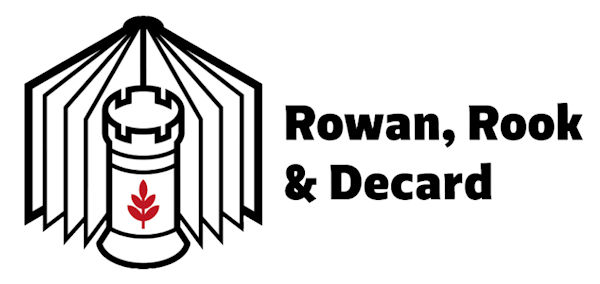
The art in Spire (by Adrian Stone) is consistently high quality throughout. It has a moody colour palette and an angular, somewhat stylized look, like a comic that’s too cool for realism. It looks amazing.
Spire is the kind of RPG book where you read a couple of pages and then have to stop and message your friends about how cool the thing you’ve just read is.
- The character class whose starting equipment includes one set of leather robes and one hyena.
- The chained god with a metal gag fused to his mouth buried in the basement levels of the city.
- The villains who regard masks as more important than faces.
 Spire
itself is a great city formed from a single huge and towering structure of
unknown origin and design. (Think of Mega-City One or a Warhammer 40K’s Hive
City.)
Spire
itself is a great city formed from a single huge and towering structure of
unknown origin and design. (Think of Mega-City One or a Warhammer 40K’s Hive
City.)
Spire is home to the drow, also known as dark elves. Dark elves are horribly burned if exposed to the rays of the sun but are no more naturally inclined towards evil than humans are. This stands in stark contrast to their depiction in D&D and most fantasy fiction.
High elves (aelfir) on the other hand are, if not genetically evil, then certainly insane, alien and dangerous to know. They’re less like Tolkien’s elves and more like faeries, particularly the faeries in Jonathan Strange and Mr Norrell. Aelfir tend to be amoral, whimsical and have about as much empathy for non-aelfir as a hungry shark.
Which is a problem. Because the aelfir conquered Spire around a hundred years ago and now hold its drow population in their jewelled fists. They demand four years of unpaid service from every drow and have banned the worship of two out of three of the drow moon goddesses.
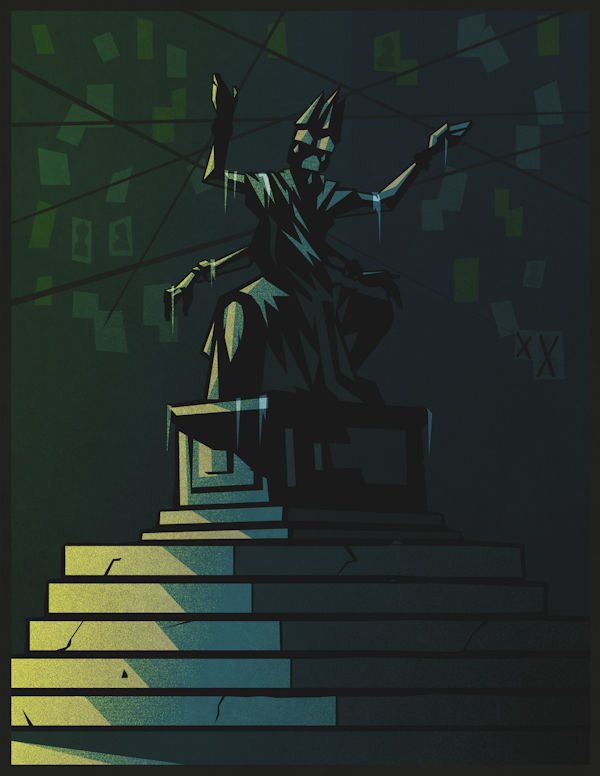 The cult of
one of the forbidden goddesses, Our Hidden Mistress, has formed a subtle and
mysterious resistance movement called the Ministry, which is dedicated to
toppling aelfir rule by any means necessary. Players take on the roles of
agents of the Ministry, called Ministers, and must decide the best way to fight
the aelfir and their lackies. Their war may be well intentioned, but it will
almost certainly lead to much loss of innocent life and likely their own deaths.
The cult of
one of the forbidden goddesses, Our Hidden Mistress, has formed a subtle and
mysterious resistance movement called the Ministry, which is dedicated to
toppling aelfir rule by any means necessary. Players take on the roles of
agents of the Ministry, called Ministers, and must decide the best way to fight
the aelfir and their lackies. Their war may be well intentioned, but it will
almost certainly lead to much loss of innocent life and likely their own deaths.
The aelfir make wonderfully distinctive villains. They get madder and more out of control in hot temperatures. They don’t necessarily show their faces even to their spouses. They think nothing in the natural world can’t be improved by their art. They compete to see whose gardener can cultivate the most virulently toxic plant and invite their friends around to watch large animals being stung to death by it.
A key part of aelfir culture is the wearing of masks. Showing your face in public is the high elf equivalent of running around naked with your arse painted scarlet. Consequently, they have ornate masks for every occasion, day and even emotional state.
Dark elves get to make their own fashion statements. Due to the whole ‘searing light of the dreaded daystar’ thing, most drow swathe themselves in cloaks and scarves and goggles and cloth wrappings. This gives them a Fremen of Dune or Sand People of Tatooine vibe, which is pretty unusual for a fantasy setting. Underneath all that gear, drow in the world of Spire can be dark black, pale white or ash grey in colour. This helps avoid the uncomfortable racial connotations of the drow in D&D.
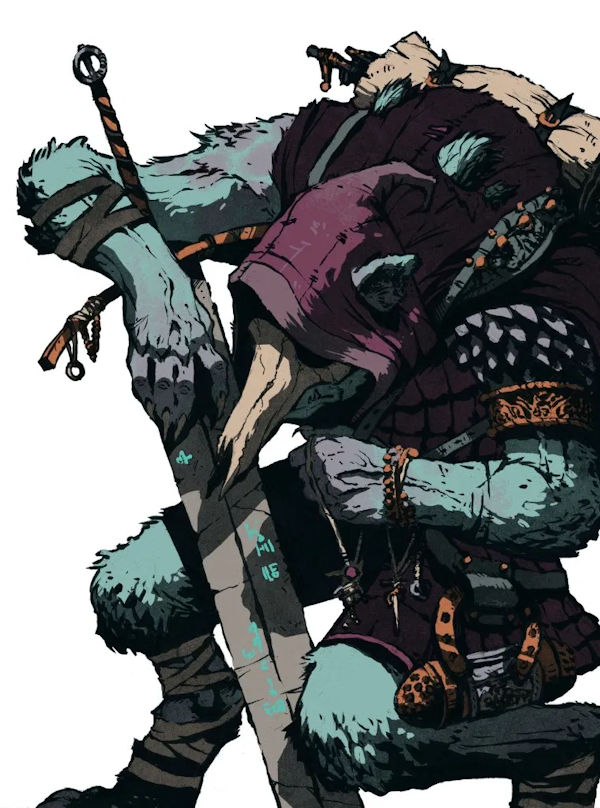 Two other
races are of some importance in this setting.
Two other
races are of some importance in this setting.
Humans, by definition the blandest of fantasy races, are actually quite interesting in the world of Spire. They are engineers and practical archaeologists who study and replicate the technologies of a long-vanished precursor race. They are the creators (or discoverers) of guns, steam-powered technology and other oddities. Though comparatively short-lived they are very useful due to the technologies they wield, so they form a significant part of the population of Spire.
Oh, and the ones outside of Spire tend live in arcologies left behind by that same elder race. (I had to look that word up, it means a self-sufficient city housed in a single structure. Though the book is quick to note that Spire is not the same as the human arcologies, even if it may have the same markers.)
Gnolls, a race of hyena-people created for D&D, have something of an Arabian Nights feel to them, though we only learn snippets about their culture in this book. The gnolls are masters of demonology and have used this hideous magic to become a power that rivals both the aelfir and the upstart humans. They are at war with the aelfir over territory. You might thing this would make them natural allies of the drow. But since most of the armies of the aelfir now consist of drow conscripts, there is likely little love lost between the dark elves and the hyena-folk. Certainly, the gnolls aren’t presented in this book as being friendly towards the Ministry, or anyone at all for that matter.
What else could I tell you about the city of Spire itself? A hundred things. But in general, it’s a city drowning in gods, cults and religious institutions of all kinds. And most of these are working towards the fulfilment of a conspiracy or malign purpose of some sort. Whether it’s to fulfil the Spire’s true purpose (as they see it) as a machine to alter reality or to spread corruption and decay as far as possible, they’ve all got something horrible up their sleeves.
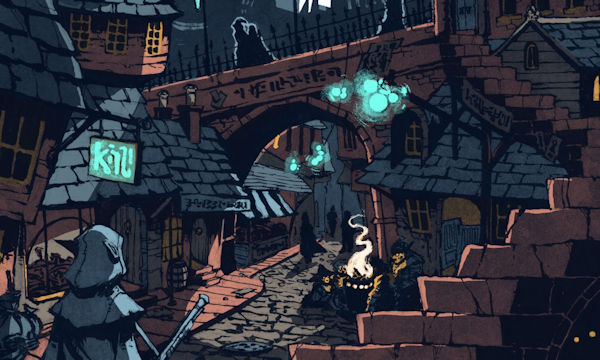
The writers of Spire describe their setting as fantasy punk. Yeah, I’ll admit to rolling my eyes at that. Everything that could be considered a new SFF subgenre risks having punk slapped on the end of it these days. Cyberpunk and steampunk were the originators of this trend and clockpunk and dieselpunk are reasonable offshoots. But it doesn’t stop there.
Want an antidote to grimdark fantasy? Try Hopepunk.
How about upbeat, ecological sci-fi? Solarpunk.
Modern versions of dated sci-fi settings? Retropunk. (Or raygun gothic, which is a brilliant term.)
Fantasy in a Chinese or East Asian style setting? Silkpunk.
Sci-fi where the technology is based around insects? Bugpunk!
Nasty horror stories where blood and organs get splashed around like a toddler’s dinner? Splatterpunk!
Fantasy where the magic is so common and so powerful it might as well be advanced technology? Dungeonpunk! (Which just sounds like some horrible blending of SFF and Fifty Shades of Grey to be honest.)
SFF based in the 60s? Transistorpunk!
You get the idea. And I’ll note that those subgenres include some brilliant works of SFF fiction. Thing is. I’d say Spire has earned the right to call itself a kind of punk. It’s grim and gritty and street level but also diverse and a bit thoughtful. It’s based around the idea of resisting the tyrannical rulers of a deeply flawed and corrupt society that turns most of the population into disposable cogs in a mighty machine. Pretty punk. And that’s before you consider the weird and sometimes alien technologies, the bionic crystal hiveminds, the sci-fi visuals and the potential for recreational body modification.
Rules
The mechanics for Spire are pretty straightforward—you roll one to four D10s (ten-sided dice), pick the highest number and compare it against a table to see if you’ve succeeded.
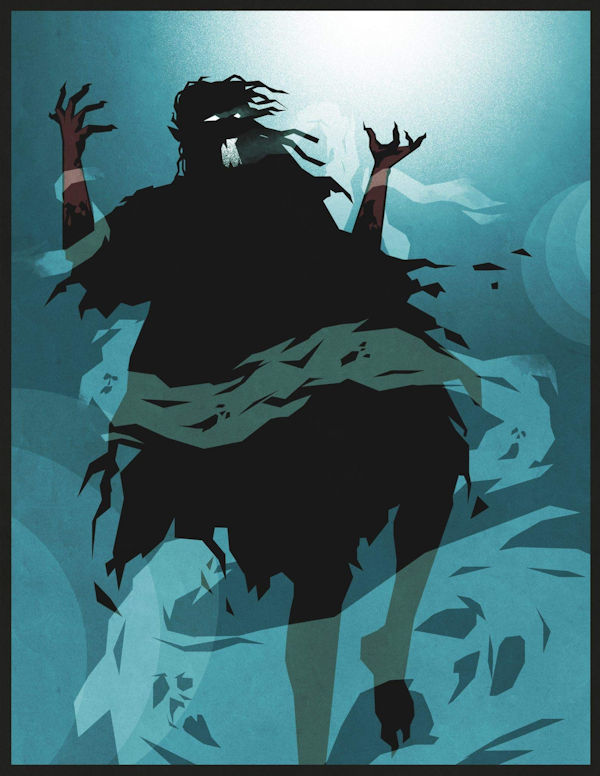 Failure or
partial success inflicts Stress. This can represent damage or danger to your
body, mind, wallet, reputation or cover. How much Stress is inflicted depends
on how dangerous or difficult the task was. In combat, for example, it’s
determined by the weapon the player character’s (PC) opponent was wielding.
Every time a Player Character suffers Stress the GM rolls to determine whether
that character suffers Fallout—potential consequences that range from a broken
leg, to insanity or to a devastating public embarrassment. The stated goal is
for Fallout to advance the plot, rather than simply punishing or weakening the
character. Death is possible, but so is exile, turning traitor or cutting a
dark deal with a god.
Failure or
partial success inflicts Stress. This can represent damage or danger to your
body, mind, wallet, reputation or cover. How much Stress is inflicted depends
on how dangerous or difficult the task was. In combat, for example, it’s
determined by the weapon the player character’s (PC) opponent was wielding.
Every time a Player Character suffers Stress the GM rolls to determine whether
that character suffers Fallout—potential consequences that range from a broken
leg, to insanity or to a devastating public embarrassment. The stated goal is
for Fallout to advance the plot, rather than simply punishing or weakening the
character. Death is possible, but so is exile, turning traitor or cutting a
dark deal with a god.
All PCs have Resistances to certain types of damage, depending on their Class and something called a Durance which we’ll come back to later. Resistances mean your character can ignore one or more points of Stress of the appropriate type when the GM is rolling for Fallout.
The standard roll is one D10. Characters gain an additional D10 if they have an appropriate Skill and another if they have an appropriate Domain. If they have Mastery of an appropriate Skill, Domain or the situation then that adds another D10. There is no way to roll more than four D10s and Mastery cannot apply more than once per roll.
Skills are fairly broad and include things like Investigate, Fight, Deceive and Pursue. They are definitely focused around the needs of the game’s setting, rather than trying to cover all possible bases.
 Domains are
a bit harder to define. They’re aspects of society, spheres of influence and
types of neighbourhood. Domains include Academia, Order, High Society,
Religion, Occult and Crime. If you can apply your Domain to the present action,
then it grants that sweet bonus D10. Crime, for example, would apply to an
attempt to pick someone’s pocket but would also apply to an attempt to
intimidate a fellow criminal. Academia would apply if you were robbing a
library or trying to impress a scholar with your knowledge.
Domains are
a bit harder to define. They’re aspects of society, spheres of influence and
types of neighbourhood. Domains include Academia, Order, High Society,
Religion, Occult and Crime. If you can apply your Domain to the present action,
then it grants that sweet bonus D10. Crime, for example, would apply to an
attempt to pick someone’s pocket but would also apply to an attempt to
intimidate a fellow criminal. Academia would apply if you were robbing a
library or trying to impress a scholar with your knowledge.
When PCs use powers, the game will often dictate which combination of Skill and Domain should be rolled. Occult doesn’t always get used for Occult spells for example.
The GM does not roll for the actions of non-player characters (NPCs) as they would in traditional RPGs. Hostile NPCs simply impose penalties on players’ rolls, reducing the number of dice they can roll. If a PC takes Stress or Fallout while opposing an NPC then the GM describes how the enemy inflicts that harm (unless they can think of an interesting way for the PC to harm themselves or suffer problems from the environment around them). Take Fallout in a street-brawl with soldiers and you might get stabbed or shot. Take Fallout while trading barbs with an aelfir dilettante in an upmarket salon and you might be made to look like a dribbling idiot.
(Side Note: Dice is a plural term. The singular form is ‘die’. The writers of Spire make it clear that they are aware of this rule and they are wilfully refusing to follow it. As a grammar purist I can assure you that they are going to Hell for this. I imagine that, having arrived, they will set themselves to taking over Hell and making it more interesting.)
No revolutionary cell can win the war alone. They need allies, patsies, patrons and suppliers. Useful relationships with NPCs are represented by Bonds. More powerful Bonds can be with an entire organisation or community. PCs can ask their Bonds to carry out tasks for them, but any task that actually helps the character will damage that relationship. Bonds suffer Stress and Fallout just like PCs. Lean too much on a Bond and they could find themselves dragged out into the street by the authorities and shot. Or they might turn traitor and spill all your secrets.
Character Creation
You don’t pick out stats or skills in Spire, at least not directly.
 First you
choose your character’s Durance. This is the four-year period of indentured
service every drow in Spire is forced to carry out at the behest of their
aelfir masters. A drow could, for example, have been a soldier, a ‘pet’ or an
agent who cut shadowy underworld deals for her master. Drow could also have
evaded their Durance and gained certain experiences or skills that way. Each
Durance, or lack thereof, grants a couple of bonuses in the form of Skills,
Domains or Resistance slots. For example, four years of backbreaking labour
increases Blood (physical resistance).
First you
choose your character’s Durance. This is the four-year period of indentured
service every drow in Spire is forced to carry out at the behest of their
aelfir masters. A drow could, for example, have been a soldier, a ‘pet’ or an
agent who cut shadowy underworld deals for her master. Drow could also have
evaded their Durance and gained certain experiences or skills that way. Each
Durance, or lack thereof, grants a couple of bonuses in the form of Skills,
Domains or Resistance slots. For example, four years of backbreaking labour
increases Blood (physical resistance).
Next, you’ll answer the most important question of the whole process. What Character Class do you want to play?
Forget the generic warrior, thief, wizard, healer combo. Every character class in Spire is unique and uniquely tied into the lore of the setting. Classes grant your character more Skills, Domains and Resistances as well as at least one inherent power and access to around a dozen Advances (extra powers that can be earned through play). They also determine your starting equipment and two initial Bonds. Let’s look at the highlights of each class.
 Azurites – Sacred
merchants who wear bright blue robes in honour of their mercantile goddess.
With the right Advances they can buy pretty much anything—including allies,
Skills, memories, the ability to shrug off wounds, temporary mastery of a
foreign language and even the ability to jump back in time by one minute.
Azurites – Sacred
merchants who wear bright blue robes in honour of their mercantile goddess.
With the right Advances they can buy pretty much anything—including allies,
Skills, memories, the ability to shrug off wounds, temporary mastery of a
foreign language and even the ability to jump back in time by one minute.
Bound – Acrobatic vigilantes with tiny gods trapped in their equipment. A Bound might possess a vampiric knife, a rope that moves on its own or cannot be unbound or gloves that cause every door they touch to be unlocked. Basically, Bound are fantasy Batman. Also, the mention of small gods implies a Pratchettian influence. Never a bad thing.
Carrion Priest – Hyena-wielding death worshippers. Among other things they can unleash supernatural slaughter, summon crows, speak to ghosts or laugh in a really creepy way (but like, reeealllly creepy). They believe the only proper form of burial is to be devoured and they aren’t always picky about waiting for a person to die of natural causes first.
Firebrand – Rabble rousing revolutionaries. They can whip up frenzied mobs, become a mob themselves, let others take the blame for them or temporarily transform into the very concept of Revolution.
 Idol – Artistic
celebrities who wield the magics of fame and creativity like twin blades
against their aelfir oppressors. They can mould themselves to reflect the
desires of others, implant suggestions in their artwork, alter reality or just
be so damn beautiful that no one dares to raise a hand against them.
Idol – Artistic
celebrities who wield the magics of fame and creativity like twin blades
against their aelfir oppressors. They can mould themselves to reflect the
desires of others, implant suggestions in their artwork, alter reality or just
be so damn beautiful that no one dares to raise a hand against them.
Knight – Hard-drinking thugs who still cling to the scraps of a noble tradition. Centuries ago the Knights were tasked with guarding Spire’s North Docks and they still exist there, operating out of various pubs. Potential knightly abilities include surprisingly plausible boasting, using their understanding of armour to gain advantages in combat, building useful short-term friendships through excessive drinking and questing to attain a magic sword.
Lajhan – Priests of the light side of the moon, the only drow goddess whose worship has not been banned by the aelfir. They are healers, guardians, seers and martyrs.
Masked – Spies who have learned the power of masks from their aelfir masters. Masked spread lies, harness their own madness or paranoia, take on all sorts of identities, steal the powers of the gods or wear spiders in such a way that they can borrow other people’s faces.
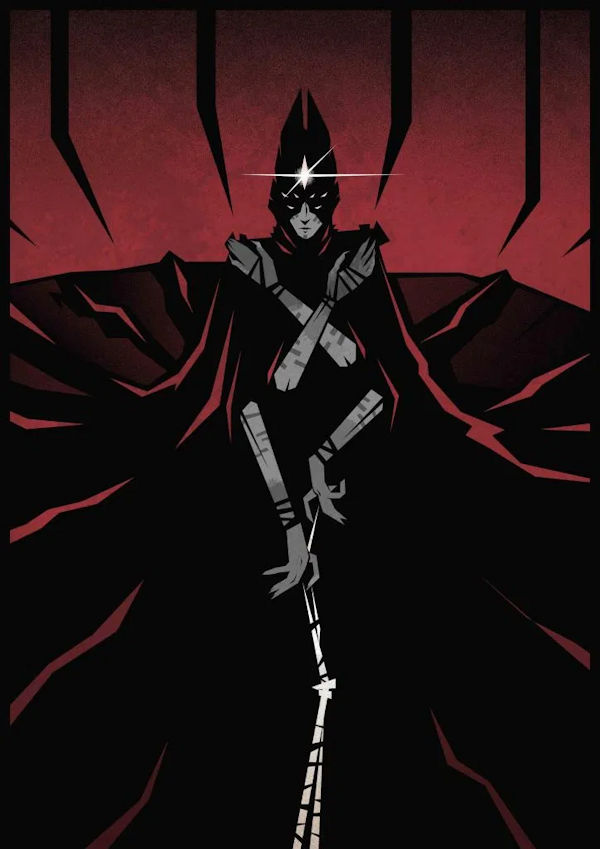 Midwife – No, it’s so much cooler than you think it is! Defenders of the eggs that will hatch the next generation of drow, they are part spider and so possess extra limbs. (All the better to stab you with.) A midwife might tear people apart with her bare hands, grow extra eyes, sprout venomous mandibles, suppress hostile magic or solve someone’s problems by wrapping them in a cocoon (no really, it works).
Midwife – No, it’s so much cooler than you think it is! Defenders of the eggs that will hatch the next generation of drow, they are part spider and so possess extra limbs. (All the better to stab you with.) A midwife might tear people apart with her bare hands, grow extra eyes, sprout venomous mandibles, suppress hostile magic or solve someone’s problems by wrapping them in a cocoon (no really, it works).
Vermissian Sage – Historians and cataloguers of a public transport system, which was so badly designed that it damaged the very fabric of space-time. Sages can hide or hunt down knowledge, open doors to the Vermissian Vault, manipulate memories or speech and even mess with reality.
There’s enough wiggle room within each class to allow them to fulfil at least a couple of different roles in the party, depending on what Advances you choose for them. Your Carrion Priest could be an enforcer with a talent for mauling the opposition, a relentless hunter or a cunning investigator. Or any combination of the above, given enough time. Other Advances can be purchased for a character who meets the requirements. These range from becoming a hardened Soldier or a City Guard who can wave their badge around, to being a cultist of the Hungry Deep whose very touch is poison, or one of the Faithful of King Teeth who can swallow people whole.
Districts and Factions
This is the biggest section of the book and deals with the city of Spire itself. It is further subdivided by Domains. For example, you get all the Districts and Factions associated with the Domain of Academia in one subsection. If you haven’t fallen in love with Spire already then this is the section that should win you over. This imaginary city seethes with creativity. It’s like an ornate painting that gets ever more baroque and complex the more you look at it. There’s just so much to see.
“A masked and feathered cult devoted to capturing the winds here, a hermitage bristling with copper resonators that buzz and hum when thunder approaches there.”
- The heights of Amaranth, where the aelfir hold masked balls amidst ornate architecture and pillars of eternal ice.
- Perch, a vigilante-haunted slum that’s literally nailed to the side of the city’s wall and might tumble into oblivion at any moment.
- The Heart. A sickening, chaotic tumour of unreality that festers at the base of Spire and could prove to be the ruin of drow and aelfir alike.
- The Lunar Font, where moonlight is captured and distilled for use in creating the sentient undead beings called ‘the undying’.
- Hanging corpse-gardens where the bodies of the dead are used as fodder for rare mushrooms.
- Characters like the bouncer who won’t throw you out for misbehaving, she’ll just destroy your reputation with a few well-chosen words.
- And creatures like the monstrous sky whales and giant riding crows.
You certainly wouldn’t want to live in this city. Dark cults and terrible fates lurk around every corner. One cult wants to kill all practitioners of occult magic. Another wish to collectively give birth to the mantis mother who will usher in a new age of insectoid song.
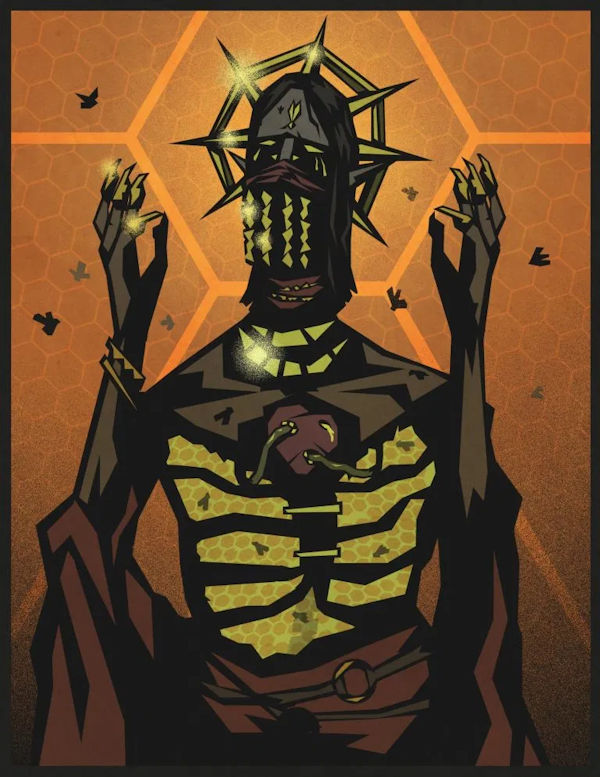 There are
people in Spire who stick crystals in their brains to commune with a machine
intelligence. There are multiple ways to be turned into a living statue. There
are doors that lead to realities beyond this one. There are city-druids and
evil paladins and blood-witches. Oh, by the way, there are also wind elves that
live on clouds and moon elves that are “black-eyed and frail” and “communicate
by searing glyphs into the night sky with smouldering biophosphorescence”.
There are
people in Spire who stick crystals in their brains to commune with a machine
intelligence. There are multiple ways to be turned into a living statue. There
are doors that lead to realities beyond this one. There are city-druids and
evil paladins and blood-witches. Oh, by the way, there are also wind elves that
live on clouds and moon elves that are “black-eyed and frail” and “communicate
by searing glyphs into the night sky with smouldering biophosphorescence”.
There’s even a description of the colourful array of drugs that are enjoyed by Spire’s inhabitants. (I did pause for a moment and worry this game might be promoting drug use. But these aren’t real drugs, they’re patently fantastical. The game also offers the option to use magical cannibalism, to murder government officials or to kidnap people and use magic to steal their identities, but it’s not advocating for people to try that in real life either.)
The writers aren’t just content to have a weird idea and leave it at that. They take the weird idea and follow it through. For example, it’s established that aelfir don’t really feel emotion like drow or humans do. So, it’s fashionable for young aelfir to take a drug called Blues that makes you feel very sad. They then hold elaborate mourning parties, listening to sombre music and sobbing on each other’s shoulders. They even have special mourning masks made to demonstrate their grief in the most artistic way possible.
All of this makes the world of Spire feel very textured and believable. It would be easy to let your imagination inhabit it.
The Religion Domain section is notable because it contains a description of the hidden base of the Ministry itself, along with further information about this mysterious organisation that employs the PCs. The Ministry’s initiation rites are pretty cool and offer extra ideas for plot seeds, Bonds and PC motivations. Though, I do wonder why they weren’t included with the character creation section instead of being buried in the middle of the city information section.
 I wasn’t
too sure about one aspect of the Ministry—recruitment. The Ministry apparently
waits around for drow to track them down and then recruits them if they prove
useful and loyal enough. Most potential recruits get killed, either by the
authorities or by the Ministry themselves. I accept this fits the gritty,
shades-of-grey themes of the setting. And it feeds into the idea that Ministers
are often expected to work things out on their own. (Not to mention the tragic
events that plague all PC in this game.) But it doesn’t feel like a very
logical or competent modus operandi for a resistance movement to follow.
It also doesn’t seem to fit in with other comments in the book e.g. that the
Ministry actively tries to recruit ex-soldiers and Bound vigilantes.
I wasn’t
too sure about one aspect of the Ministry—recruitment. The Ministry apparently
waits around for drow to track them down and then recruits them if they prove
useful and loyal enough. Most potential recruits get killed, either by the
authorities or by the Ministry themselves. I accept this fits the gritty,
shades-of-grey themes of the setting. And it feeds into the idea that Ministers
are often expected to work things out on their own. (Not to mention the tragic
events that plague all PC in this game.) But it doesn’t feel like a very
logical or competent modus operandi for a resistance movement to follow.
It also doesn’t seem to fit in with other comments in the book e.g. that the
Ministry actively tries to recruit ex-soldiers and Bound vigilantes.
I guess this can be justified in-setting by the fact that the Ministry is a cult as much as a resistance movement. A cult to a goddess of secrets no less. Still, if running Spire, I think I would clarify this to my players by explaining that the Ministry actively recruits spies, thugs etc. to serve its ends but doesn’t tell them who they’re serving. Only those who are valuable, loyal and competent enough to penetrate the first layer of secrecy surrounding the organisation get the chance to become full-fledged Ministers. (The book actively encourages you to tweak the city to your own preferences anyway.)
The Ministry isn’t the only organisation in Spire that opposes the aelfir and it certainly isn’t the only illegal organisation. There’s the cult of the blood moon for example, who use fanatical extremism and brutality in place of the Ministry’s subtle underhandedness. And we’ve already discussed some of the other groups that plague the city. This tangle of different resistance movements and cults all infiltrating each other openly and in secret, while occasionally degenerating into all out conflict feels a lot like stories of World War II. The enemy of my enemy might not be my friend, particularly if they want to use demonology to turn me into a walking bomb.
Running the Game
Spire is a modern game and makes use of the concept of Lines and Veils as well as the X Card. It also encourages collaborative storytelling to an extent and makes a fair argument for it. One bit of advice stood out to me. The received wisdom for most RPGs is you should never split the party. (There’s even a song about it.) Spire firmly rejects that idea.
“CUT BETWEEN SCENES Don’t be afraid to have multiple scenes running at once. Maybe one group of players stays back to hold off reinforcements and a second group runs off to spring their ally from jail. Maybe a group of researchers is frantically looking for a sorcerer’s weakness while the other half of the party sneaks through his house, aiming to interrupt his dark ritual.”
Sounds a bit tricky to me, but more power to you if you can pull it off.
Appendices
This is a pretty big chunk of the book. First, a set of Kickstarter rewards has led to eight extra gods being added in the first appendix. These offer even more strange powers to PCs. The writers clearly can’t get enough of strange powers and I’m not going to argue.
“In the depths of Pilgrim’s Walk, through several hidden doors and trapped portals, the god known as Carabys is chained to the flagstones. His mouth is gagged with a sutured-on plate of metal, for when he speaks, his words cause madness, death, and sin.”
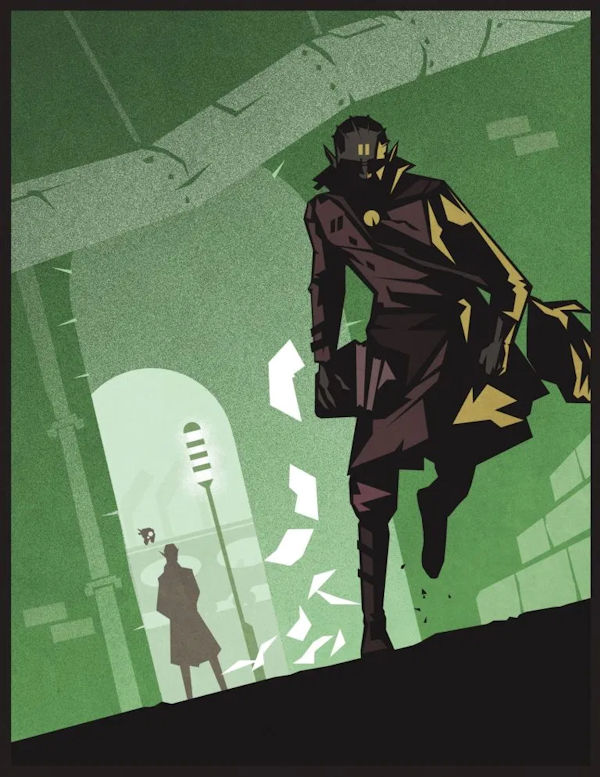 After that
there’s an eclectic mix of random tables including ‘Things You Find in the
Vermissian’ and ‘The Theme of this Aelfir Party’.
After that
there’s an eclectic mix of random tables including ‘Things You Find in the
Vermissian’ and ‘The Theme of this Aelfir Party’.
Other Appendices include a list of the different species of goats in Spire, with descriptions. I don’t know why.
Most intriguing was a list of the Protakos Arcologies, which the humans have discovered and exploited. Featuring lost cities, weird metallic guardians and cursed colonies. There’s potential for a whole new game there, though I’m not aware of any plans by Rowan, Rook and Decard in that direction.
Finally, we get an eclectic list of the writers’ influences, which really drives home the odd blend of styles that make up Spire. Things like Dredd, Dark Heresy, Changeling: The Lost, Bloodborne and, of course, Perdido Street Station. Fallen London also gets a name check, which makes sense because that series of video games has one of the most elaborate, byzantine, bizarre and ultimately horrific settings I’ve ever encountered.
Final Thoughts
I got a friend who likes Blades in the Dark (which has some similar themes and play-styles to Spire) to give this book a once-over. She loved the setting and liked the rules well enough. She didn’t like being locked into working for a specific organisation with one particular goal in mind. I can understand that. Rowan, Rook and Decard have created such a fascinating and multi-layered world for their drow resistance game that it seems a shame to limit the kinds of story you can tell in it.
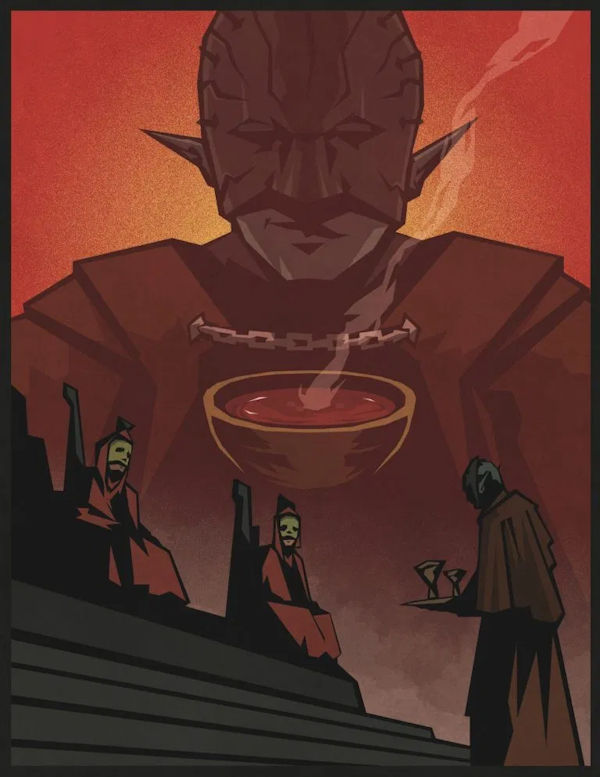 It’d be
great fun to play gnoll saboteurs, human tech-hunters, competing cultists or
(if you’re the sort of person who plays Chaotic Evil characters in D&D)
scheming aelfir. And it wouldn’t be difficult to alter the game to allow you to
do that. There just isn’t any support for that approach in the core book.
It’d be
great fun to play gnoll saboteurs, human tech-hunters, competing cultists or
(if you’re the sort of person who plays Chaotic Evil characters in D&D)
scheming aelfir. And it wouldn’t be difficult to alter the game to allow you to
do that. There just isn’t any support for that approach in the core book.
So. Do I myself have any gripes with this book? Not many and they’re all matters of personal taste.
I miss having a dedicated section for antagonists. Most areas include at least one description of a group of local NPCs who are up for a scrap, but I’d have preferred to have had them all together. This is more out of force of habit though to be honest and I’m sure that, having used this book enough, I’ll come to appreciate being able to locate a point of interest and an associated encounter in the same place. And it’s really not difficult to throw together antagonists in this game, you can do it in a matter of seconds.
Speaking of antagonists. Enemies in Spire are, by nature of the rules, reactive to what the player characters are doing. This is certainly not unusual among modern RPGs like Blades in the Dark, powered by the Apocalypse and Genesys. But it feels a little strange to me when PCs have a huge array of cool powers, but NPCs are mostly limited to inflicting damage. Even NPCs like ghouls or Bound who clearly should have access to the same Advances as their PC colleagues don’t have an obvious mechanical way of using them. I like to be able to field a villain who can stroll into a room and set a PC on fire with her mind or send half the party fleeing in supernatural terror. Still, I suppose nothing prevents a GM from having a villain do something awful and asking the players how they deal with that problem.
(Once I got onto reading the supplements for Spire, I realised it does allow the villains to be more proactive than I thought. But that wasn’t the impression I got from the core book, so I’ll stand by it for the first part of this review.)
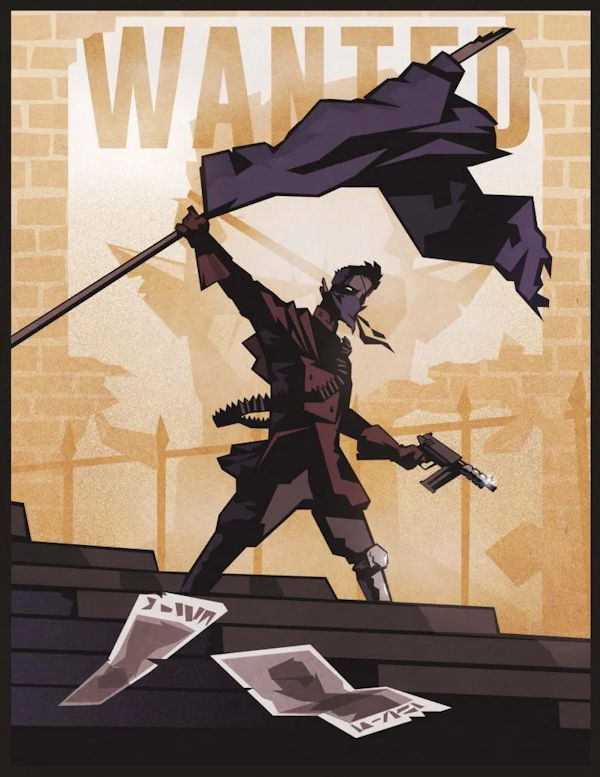 Spire also emphasises difficult moral
choices and horrible consequences for your Ministers’ actions. I get the
impression that if at least one player doesn’t cry during the course of a
campaign then you’re not running it the way the writers intended. Ideally the
campaign should end with someone having to take a year out to re-evaluate their
life after realising they’re a fundamentally awful person.
Spire also emphasises difficult moral
choices and horrible consequences for your Ministers’ actions. I get the
impression that if at least one player doesn’t cry during the course of a
campaign then you’re not running it the way the writers intended. Ideally the
campaign should end with someone having to take a year out to re-evaluate their
life after realising they’re a fundamentally awful person.
Ok, ok. I’m hamming this up for effect. Rowan, Rook and Decard don’t want you to traumatise your players. But it is true that Spire is a horror game. Not horror in the sense of having to deal with ghosts and ghouls or abominations from beyond time and space (though it can absolutely do that). Like Vampire: The Requiem or Delta Green this is a game of personal horror, the horror of having no good choices, of having to either die as a failure or live as a monster. If that sounds good to you then you need look no further. Personally, I’ve used RPGs to tell that kind of story but it’s not one I want to be locked into.
And that’s ok. Spire is explicitly there to be altered to your tastes. I certainly got enough setting out of it to want to use it to run a game and nothing in the mechanics would prevent me from creating more upbeat storylines.
Go out and buy Spire. Even if you’re not planning to run or play a new RPG anytime soon, it will give you ideas for your next campaign, regardless of whether you’re running fantasy, sci-fi, cyberpunk, pulp, post-apocalyptic or horror.
What if you’re not a roleplayer? You know what? If you like immersing yourself in strange fantasy worlds and can afford the price of admission then go ahead and buy Spire anyway. Even if you never play Spire, you’ll have a lot of fun reading it.
Quick shout-out to Garblag Games, whose Let’s Play of Spire led me to this awesome game. Look out for the second and final part of this review next month, where I’ll be covering Strata, Black Magic and some other supplements for Spire.
You can read part two of this review here.
Disclaimer: I received free digital copies of Spire and six of its supplements in return for an honest review.



I’m so very glad to hear there’s a variety of skin tones for the drow in this RPG. And the worldbuilding sounds fantastic. Thank you for writing about this. Will check it out.